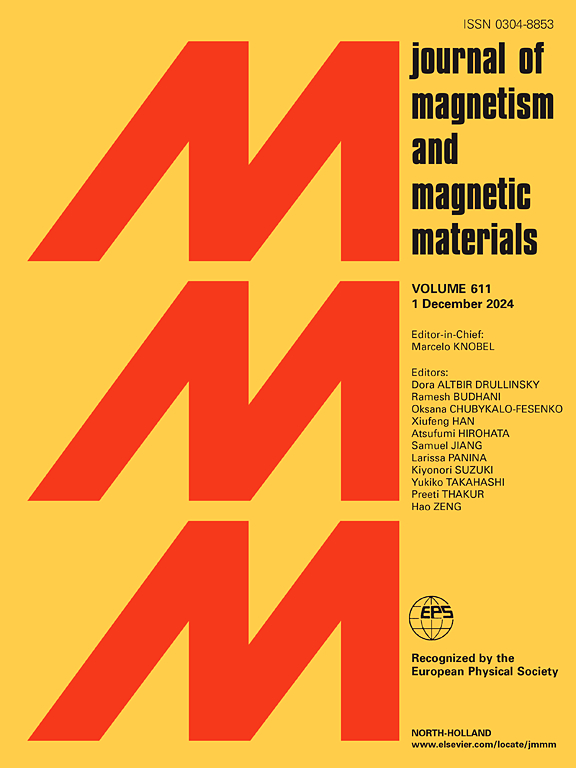Analysis of Microstructural, Electronic and Magnetic Properties of Nanocrystalline Compound Sm2ZrCo16: Effects of Annealing Temperature and Role of Intergranular Exchange Coupling
IF 2.5
3区 材料科学
Q3 MATERIALS SCIENCE, MULTIDISCIPLINARY
引用次数: 0
Abstract
In this study, we investigated the microstructural, electronic, and magnetic properties of nanocrystalline Sm2ZrCo16 alloys. This compound adopts a trigonal structure with a space group P3̅m1 [164] and exhibits a Curie temperature TC of approximately 798 K. Quantitative analysis of the electronic structure, magnetic structure, exchange interactions (Jij), and band structure was performed using Density Functional Theory (DFT) calculations implemented in the Wien2k code. DFT calculations predicted a density of states indicating a pronounced ferromagnetic behavior. The mean-field theory (MFT) method was used to estimate the Curie temperature (TC) from the exchange interactions (Jij) obtained between different atoms, with an implementation of MFT in a Python code. We analyzed the influence of the annealing temperature (Ta) on the magnetic performances of these samples, with the main objective of identifying the mechanisms responsible for the improvement of the magnetic properties as a function of Ta. An analysis of the intergranular exchange coupling (IGEC) and grain size revealed that the coercivity (HC) reaches a maximum value of 29632 Oe at Ta = 898 K. This improvement is attributed to grain size optimization and enhanced IGEC, which improves magnetic anisotropy and resistance to magnetic domain reversion. However, higher annealing temperatures result in excessive grain growth, leading to a decrease in coercivity (HC). The novelty of this work lies in the precise identification of annealing conditions to maximize the magnetic properties of this compound, while exploring the crucial role of IGEC in these improvements. This research opens new perspectives for the design of high-performance nanostructured magnetic materials based on the Sm2ZrCo16 alloy.

纳米晶化合物Sm2ZrCo16的显微组织、电子和磁性能分析:退火温度的影响和晶间交换耦合的作用
在本研究中,我们研究了纳米晶 Sm2ZrCo16 合金的微观结构、电子和磁性能。使用 Wien2k 代码实现的密度泛函理论(DFT)计算对电子结构、磁性结构、交换相互作用(Jij)和能带结构进行了定量分析。DFT 计算预测的状态密度表明该物质具有明显的铁磁性。我们使用均场理论(MFT)方法,通过不同原子间的交换相互作用(Jij)来估算居里温度(TC),并在 Python 代码中实现了 MFT。我们分析了退火温度(Ta)对这些样品磁性能的影响,主要目的是找出导致磁性能随 Ta 变化而改善的机制。对晶粒间交换耦合(IGEC)和晶粒尺寸的分析表明,Ta = 898 K 时矫顽力(HC)达到最大值 29632 Oe。然而,较高的退火温度会导致晶粒过度生长,从而降低矫顽力(HC)。这项工作的新颖之处在于精确确定了退火条件,以最大限度地提高这种化合物的磁性能,同时探索了 IGEC 在这些改进中的关键作用。这项研究为基于 Sm2ZrCo16 合金设计高性能纳米结构磁性材料开辟了新的前景。
本文章由计算机程序翻译,如有差异,请以英文原文为准。
求助全文
约1分钟内获得全文
求助全文
来源期刊

Journal of Magnetism and Magnetic Materials
物理-材料科学:综合
CiteScore
5.30
自引率
11.10%
发文量
1149
审稿时长
59 days
期刊介绍:
The Journal of Magnetism and Magnetic Materials provides an important forum for the disclosure and discussion of original contributions covering the whole spectrum of topics, from basic magnetism to the technology and applications of magnetic materials. The journal encourages greater interaction between the basic and applied sub-disciplines of magnetism with comprehensive review articles, in addition to full-length contributions. In addition, other categories of contributions are welcome, including Critical Focused issues, Current Perspectives and Outreach to the General Public.
Main Categories:
Full-length articles:
Technically original research documents that report results of value to the communities that comprise the journal audience. The link between chemical, structural and microstructural properties on the one hand and magnetic properties on the other hand are encouraged.
In addition to general topics covering all areas of magnetism and magnetic materials, the full-length articles also include three sub-sections, focusing on Nanomagnetism, Spintronics and Applications.
The sub-section on Nanomagnetism contains articles on magnetic nanoparticles, nanowires, thin films, 2D materials and other nanoscale magnetic materials and their applications.
The sub-section on Spintronics contains articles on magnetoresistance, magnetoimpedance, magneto-optical phenomena, Micro-Electro-Mechanical Systems (MEMS), and other topics related to spin current control and magneto-transport phenomena. The sub-section on Applications display papers that focus on applications of magnetic materials. The applications need to show a connection to magnetism.
Review articles:
Review articles organize, clarify, and summarize existing major works in the areas covered by the Journal and provide comprehensive citations to the full spectrum of relevant literature.
 求助内容:
求助内容: 应助结果提醒方式:
应助结果提醒方式:


